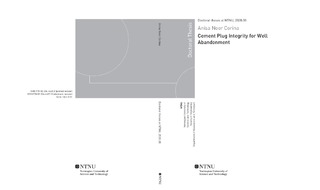| dc.contributor.advisor | Sangesland, Sigbjørn | |
| dc.contributor.advisor | Skalle, Pål | |
| dc.contributor.advisor | Vrålstad, Torbjørn | |
| dc.contributor.author | Corina, Anisa Noor | |
| dc.date.accessioned | 2020-02-13T12:28:49Z | |
| dc.date.available | 2020-02-13T12:28:49Z | |
| dc.date.issued | 2020 | |
| dc.identifier.isbn | 978-82-326-4427-8 | |
| dc.identifier.issn | 1503-8181 | |
| dc.identifier.uri | http://hdl.handle.net/11250/2641562 | |
| dc.description.abstract | Permanent abandonment marks the end of the life of an oil or gas well. Accordingly, the penetrated formation must be isolated, preventing fluid flow to the surface or surrounding formation, with a purpose to give long-term environmental protection. The isolation is generally achieved by placing qualified sealing material, commonly cement, in the wellbore at specific intervals. Recently, there have been concerns about the sealing performance of the cement plug to create lasting isolation, knowing that the cement hydraulic integrity could be compromised under various conditions one can encounter downhole. Therefore, enhanced insight about cement plug sealing could provide the possibility to improve the planning and design of well abandonment operations in reducing the risk of integrity issues in plugged wells.
A laboratory test assessing the sealing ability of a material to a pipe can be a relevant approach for analyzing the hydraulic integrity of the cement plug. A literature study reveals that there were only a few numbers of experimental studies investigating sealing performance of cement plug, and the outcomes were dispersed and fragmented due to the lack of consistent experimental setup. This highlights that further investigations may be sought to yield additional information on the hydraulic integrity of cement plugs.
This research work aims to evaluate the sealing performance of cement plugs for permanent well abandonment by using a function test apparatus, constructed in the SINTEF laboratory. The test setup is based on the design from an existing study, which was also adopted in one of the Oil and Gas UK guidelines. It is a small-scale replica of a downhole system constituted of a cement plug enclosed inside a pipe. It has unique features that allow uninterrupted consecutive processes of curing and testing, and it can simulate the realistic downhole condition. In principle, the test is performed by subjecting a differential pressure and a flowing gas across a cement plug placed inside a test cell. The gas flow rate through the cement plug is measured and used as an indicator if the hydraulic sealing of the cement plug is compromised. The differential pressure during the first sign of a leak is also measured.
First, a preliminary test is conducted to examine the setup functionality, generate the baseline results, and compare cement curing conditions in results reproducibility. As the setup is found to be operational and the dry-curing method (i.e. curing without access to external water) is set in the testing protocol, comparative experiments are subsequently conducted. In these experiments, two cement systems of neat- and silica-based cement are tested with investigated parameters of pipe surface roughness, curing temperature, and cement additives. The results show that placement of the cement plugs next to a rough-surface pipe and addition of expanding agents are both effective in reducing the gas leak rate, and they can be implemented to improve the integrity of the cement plug.
As the experimental results observed that leak was likely to occur at the microannulus between cement and pipe interface, this research work covers the investigation of the fluid flow dynamics in microannuli. The fluid dynamic study is conducted by using numerical simulation of computational fluid dynamics (CFD) and divided into two parts. The first part investigates the fluid flow dynamics of three fluid types - methane gas, water, and oil - in the microannuli: (i) from real cases and (ii) from the theoretical-based model (uniform microannuli). Furthermore, the second part investigates the fluid flow dynamics in uniform microannuli with different wall roughness, and it is a complement analysis of the experimental works investigating the effect of pipe surface roughness on the cement plug sealing. The overall simulation results suggest that the fluid flow phenomena in the actual microannuli depend on the microannuli morphology and the flowing fluid properties. Such microannuli with tortuous shape and low-connectivity potentially increase the resistance for fluid to flow. | nb_NO |
| dc.language.iso | eng | nb_NO |
| dc.publisher | NTNU | nb_NO |
| dc.relation.ispartofseries | Doctoral theses at NTNU;2020:30 | |
| dc.relation.haspart | Paper 1:
Opedal, Nils; Corina, Anisa Noor; Vrålstad, Torbjørn.
Laboratory Test on Cement Plug Integrity.
Proceedings of the ASME 2018 37th International
Conference on Ocean, Offshore and Arctic Engineering
OMAE2018, Paper No: OMAE2018-78347, V008T11A071
https://doi.org/10.1115/OMAE2018-78347 | nb_NO |
| dc.relation.haspart | Paper 2: Corina, Anisa Noor; Opedal, Nils van der Tuuk; Vrålstad, Torbjørn; Sangesland, Sigbjørn. Cement Plug Sealing Studies of Silica Cement Systems. I: ASME 2019 38th International Conference on Ocean, Offshore and Arctic Engineering (OMAE2019): Volume 8: Polar and Arctic Sciences and Technology; Petroleum Technology. ASME Press 2019 ISBN 978-0-7918-5887-5 | nb_NO |
| dc.relation.haspart | Paper 3:
Corina, Anisa Noor; Opedal, Nils; Vrålstad, Torbjørn; Skorpa, Ragnhild; Sangesland, Sigbjørn.
The Effect of Casing Pipe Roughness on Cement Plug Integrity.
SPE-194158-PA
- Is not included due to copyright available at
https://doi.org/10.2118/194158-PA | nb_NO |
| dc.relation.haspart | Paper 4:
Corina, Anisa Noor; Skorpa, Ragnhild; Sangesland, Sigbjørn; Vrålstad, Torbjørn.
Fluid Flow Analysis of Different Fluid Types Flowing Through Real Microannuli
- This paper is awaiting publication and is not included in NTNU Open | nb_NO |
| dc.title | Cement Plug Integrity for Well Abandonment | nb_NO |
| dc.type | Doctoral thesis | nb_NO |
| dc.subject.nsi | VDP::Technology: 500::Rock and petroleum disciplines: 510::Petroleum engineering: 512 | nb_NO |

